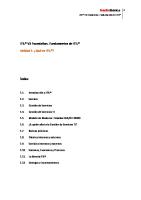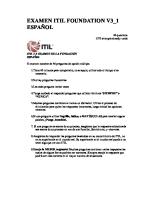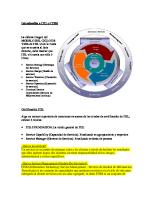ITIL Foundation v3 2011 Test Exam 1
Questions 1 Which one of the following is NOT a ITIL Phase? a. Service Catalogue b. Service Design. c. Service Operation
Views 352 Downloads 4 File size 86KB
Recommend stories
- Author / Uploaded
- Eduardo Mora Perez
- Categories
- Itil
- Seguridad de información
- It Service Management
- Tecnología
- Tecnologías de la información
Citation preview
Questions 1 Which one of the following is NOT a ITIL Phase? a. Service Catalogue b. Service Design. c. Service Operation. d. Continual Service Improvement. 2. Which phase is in charge of deal with the customer requirements and customer service levels? a. Service Catalogue. b. Continual Service Improvement. c. Service Operation. d. Service Design. 3. Value consists on? a. Utility and Quality b. Customer and Service c. Utility and Warranty d. Delivering value to customers 4. ITSM is the correct mix of what elements? a. Technology, incidents and customer b. People, process and information technology c. People, information technology and processes d. People, customer and users 5. Technical Management is NOT responsible for? a. Maintenance of the technical infrastructure b. Documenting and maintaining the technical skills required to manage and support the IT Infrastructure c. Diagnosis of, and recovery from technical failures d. Defining the Operational Level Agreements for the technical teams 6. Which of these is the CORRECT description of normal service operation? a. The service is operating in the way it usually does when there hasn't been an incident b. The service is operating within the limits defined in the Service Level Agreement c. The service is providing all functionality and performance that the business wants d. All users are able to log in to the service and use it 7. Consider the following statements: 1. Continual Service Improvement (CSI) provides guidance on how to improve process efficiency and effectiveness 2. CSI provides guidance on how to improve services 3. CSI provides guidance on the improvement of all phases of the Service Lifecycle 4. CSI provides guidance on the measurement of processes and services Which of the above statements is CORRECT? a. 1 and 2 only b. 2 only c. 1, 2 and 3 only d. All of the above 8. Which of the following are the three main types of metrics as defined in Continual Service Improvement (CSI)? 1. Process Metrics 2. Supplier Metrics
3. Service Metrics 4. Technology Metrics 5. Business Metrics a. 1, 3 and 4 b. All of them c. 1 and 2 d. 3 and 4 9. Which of the following would be stored in the definitive media library (DML)? 1. Copies of purchased software 2. Copies of internally-developed software 3. Relevant licence documentation 4. The change schedule a. All of the above b. 1 and 2 only c. 1, 2 and 3 only d. 3 and 4 only 10. Which of the following is NOT a step in the Continual Service Improvement (CSI) model? a. What is the vision? b. Is there a budget? c. Did we get there? d. Where are we now? 11. The spell check module of a word-processing software package contains a number of errors. The Development department has corrected these errors in a new version. Which process is responsible for ensuring this updated version is tested? a. Release Management b. Configuration Management c. Incident Management d. Problem Management 12. What is the purpose of the request fulfilment process? a. Making sure all requests within an IT organization are fulfilled b. Ensuring fulfilment of change requests c. Making sure the service level agreement (SLA) is met d. Dealing with service requests from the users 13. Which of the following is the correct set of steps for the Continual Service improvement (CSI) Model? a. Devise a strategy; Design the solution; Transition into production; Operate the Solution; continually improve b. Where do we want to be?; How do we get there?; How do we check we arrived; How do we keep the momentum going? c. identifies the required business outcomes; Plan how to achieve the outcomes; Implement the plan; Check the plan has been properly implemented; improve the solution d. What is the vision?; Where are we now?; Where do we want to be?; How do we get there?; Did we get there?; How do we keep the momentum going? 14. A user reports a PC problem to the Service Desk. A Service Desk representative determines that the PC is defective and indicates that according to the services catalogue, the PC will be replaced within three hours. Which ITIL process is responsible for having this user’s PC replaced within three hours? a. Availability Management b. Change Management c. Configuration Management
d. Service Level Management 15. Information is regularly exchanged between Problem Management and Change Management. What information is this? a. RFCs resulting from Known Errors b. Known Errors from Problem Management, on the basis of which Change Management can generate Requests for Change (RFCs) c. RFCs from the users that Problem Management passes on to Change Management d. RFCs from the Service Desk that Problem Management passes on to Change Management 16. Which of the following processes need to carry out risk assessment and management against services? 1. IT service continuity management 2. Information security management 3. Service catalogue management a. All of the above b. 1 and 3 only c. 1 and 2 only d. 2 and 3 only 17. Which of the following is the BEST description of an operational level agreement (OLA)? a. A written agreement between the IT service provider and their customer(s) defining key targets and responsibilities of both parties b. An agreement between an IT service provider and another part of the same organization that assists in the provision of services c. An agreement between two service providers about the levels of service required by the customer d. An agreement between a 3rd (third) party service desk and the IT customer about fix and response times 18. What are the three sub-processes of capacity management? a. Business capacity management, service capacity management and component capacity management b. Supplier capacity management, service capacity management and component capacity management c. Supplier capacity management, service capacity management and technology capacity management d. Business capacity management, technology capacity management and component capacity management 19. Which of the following are the purposes or objectives of the release and deployment management process? 1. To define and agree release and deployment plans 2. To ensure release packages can be tracked 3. To authorize changes to support the process a. All of the above b. 2 and 3 only c. 1 and 3 only d. 1 and 2 only 20. Which of the following CANNOT be stored and managed by a tool? a. Knowledge b. Information c. Wisdom d. Data
21. Which of the following best describes the goal of Information Security Management Process? a. To ensure that that the information security risks are appropriately managed and enterprise information resources are used responsibly. b. To provide a focus for all aspects of IT security and manage all IT security activities. c. To align IT security with business security and ensure that information security is effectively managed in all service and Service Management activities d. To provide the strategic direction for security activities and ensures objectives are achieved 22. Which of the following are the four Ps of service design? a. Planning, products, position, processes b. People, partners, products, processes c. Planning, perspective, position, people d. Perspective, partners, problems, people 23. Which of the following questions does guidance in Service Strategy help answer? 1: What services should we offer and to whom? 2: How do we differentiate ourselves from competing alternatives? 3: How do we truly create value for our customers? a. 2 only b. 3 only c. 1 only d. All of the above 24. The MAIN objective of Service Level Management is: a. To carry out the Service Operations activities needed to support current IT services b. To ensure that sufficient capacity is provided to deliver the agreed performance of services c. To ensure that an agreed level of IT service is provided for all current IT services d. To create and populate a Service Catalogue 25. Which of the following is NOT a valid objective of Request Fulfilment? a. To provide information to users about what services are available and how to request them b. To update the Service Catalogue with services that may be requested through the Service Design c. To provide a channel for users to request and receive standard services d. To source and deliver the components of standard services that have been requested 26. Which Functions are included in IT Operations Management? a. Network Management and Application Management b. IT Operations Control and Facilities Management c. Technical Management and Application Management d. Facilities Management and Technical Management 27. What are the types of activity within Demand Management? a. Activity based, Business activity patterns and user profiles b. Activity based, Access Management c. Analytical based, Business activity patterns and user profiles d. Analytical based, Shaping user behavior 28. Which of the following statements BEST describes a Definitive Media Library (DML)? a. A secure library where definitive authorized versions of all media Configuration Items (CIs) are stored and protected b. A secure location where definitive hardware spares are held c. A database that contains definitions of all media Cis d. A secure library where definitive authorized versions of all software and back-ups are stored and protected
29. What is the BEST description of the purpose of Service Operation? a. To decide how IT will engage with suppliers during the Service Management Lifecycle b. To proactively prevent all outages to IT Services c. To design and build processes that will meet business needs d. To deliver and manage IT Services at agreed levels to business users and customers 30. The group that authorizes Changes that must be installed faster than the normal process is called the: a. Technical Management Board b. Emergency Change Advisory Board (ECAB) c. Urgent Change Board (UCB) d. Urgent Change Authority (UCA) 31. Which of the following is step 1 in the 7 Step Improvement Process? a. Prepare for action b. Where are we now? c. Identify gaps in Service Level Agreement (SLA) achievement d. Define what you should measure 32. Which of the following BEST describes a Service Desk? a. A dedicated number of staff handling Incidents and service requests b. A dedicated number of staff answering questions from users c. A dedicated number of staff handling service requests d. A process within Service Operation providing a single point of contact 33. Which process is responsible for recording relationships between service components? a. Asset Management b. Service Portfolio Management c. Incident Management d. Service Asset and Configuration Management 34. Which of the following models would be most useful in helping to define an organizational structure? a. Service Model b. Continual Service Improvement (CSI) Model c. Plan, Do, Check, Act (PDCA) Model d. RACI Model 35. Which stages of the Service Lifecycle does the 7 Step Improvement Process apply to? a. Service Design, Service Transition and Service Operation b. Service Transition and Service Operation c. Service Operation. d. Service Strategy, Service Design, Service Transition, Service Operation and Continual Service Improvement 36. Which role you MOST expect to be involved in the management of Underpinning Contracts? a. Supplier Manager b. Process Manager c. IT Designer /Architect d. Service Catalogue Manager 37. Which of the following combinations covers all the roles in Service Asset and Configuration Management? a. Configuration administrator/ Librarian; Configuration Manger; Service Desk Manager; Configuration Analyst; CMS/ Tools Administrator
b. Configuration administrator/Librarian; Service Asset Manager; Configuration Manager; Configuration Analyst; Configuration control board; CMS/ Tools Administrator c. Configuration Manager; Configuration Analyst; CMS/ Tools Administrator; Librarian; Change Manger d. Configuration Administrator/ Librarian; Configuration Manager; Configuration Analyst; Configuration control board; CMS/ Tools Administrator; Financial Asset Manager 38. The MAIN purpose of Service Portfolio is to describe services in terms of: a. Functionality b. IT Assets c. Business value d. Service Level Requirements 39. How does Problem Management work with Change Management? a. By installing changes to fix problems b. By negotiating with Incident Management for changes in IT for Problem Resolution c. By issuing RFCs for permanent solutions d. By working with users to change their IT configurations 40. The BEST description of the guidance provided by Service Design is? a. The design and development of services and service management processes b. The day -to -day operation and support of services c. The design and development of new services d. The design and development of service improvements
Answers
1.-
a
2.3.4.5.6.7.8.9.10.11.12.13.14.15.16.17.18.19.20.21.22.23.24.25.26.27.28.29.30.31.32.33.34.35.36.37.38.39.40.-
d c b d b d a c b a d d b a c b a d c c b d c b b a a d b d a d d d a b c c a









